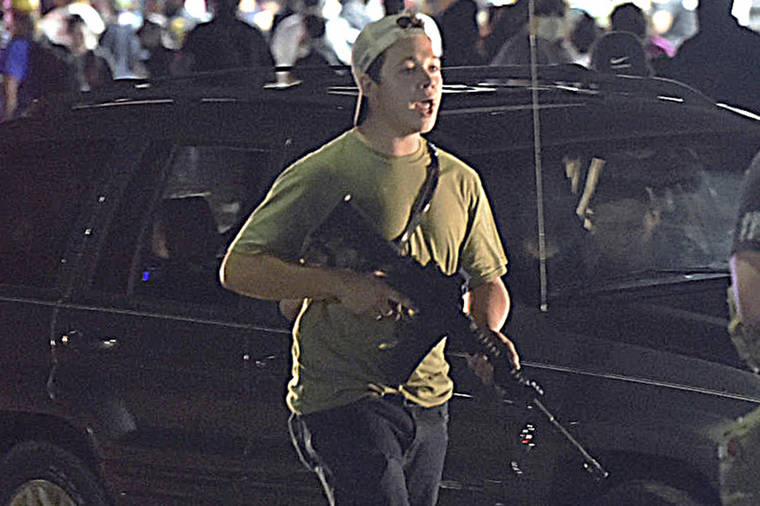CHICAGO — A 17-year-old accused of killing two protesters days after Jacob Blake was shot by police in Kenosha, Wis., is due back in court today as his attorneys fight efforts to send him to Wisconsin to stand trial on homicide charges.
No immediate decision is expected during Kyle Rittenhouse’s scheduled hearing in Lake County, Illinois. At Rittenhouse’s last court hearing in late September, Judge Paul Novak gave his attorneys two weeks to prepare filings and said he would then schedule a hearing on the issue.
In court records filed late Thursday, Rittenhouse’s attorneys argued that he was acting in self-defense and extraditing him to Wisconsin authorities would violate his constitutional rights.
They also argue that Wisconsin prosecutors and Illinois authorities didn’t follow legal technicalities required for extradition. A Kenosha County prosecutor didn’t immediately respond to an email after hours on Thursday about the extradition paperwork.
Extradition is typically a straightforward process, and legal experts have expressed doubt that Rittenhouse’s attorneys could successfully prevent a court from sending him to Wisconsin to face charges there.
His arrest has become a rallying point for some on the right, with a legal defense fund that has attracted millions in donations. But others see Rittenhouse as a domestic terrorist whose presence with a rifle incited the protesters.
The document echoes attorneys’ previous portrayal of Rittenhouse as a courageous patriot who was exercising his right to bear arms during unrest over the shooting of Blake, who is Black.
Extraditing Rittenhouse, they claim, “would be to turn him over to the mob.”
“The premature and unsupported charges are contributing to unwarranted public condemnation,” attorneys wrote. “Rittenhouse has been publicly branded a ‘mass murderer,’ a ‘terrorist,’ a ‘racist,’ and more.”
Rittenhouse was arrested at his home in Antioch, Illinois, a day after prosecutors say he shot and killed two protesters and injured a third during unrest on the streets of Kenosha on Aug. 25 over Blake’s shooting.
Rittenhouse, who is white, is charged with first-degree intentional homicide in the killing of two white protesters and attempted intentional homicide in the wounding of a third. He also faces a misdemeanor charge of underage firearm possession for wielding a semi-automatic rifle.
Like Rittenhouse, the two men killed and the third man wounded were or are white. If convicted of first-degree homicide, Rittenhouse would be sentenced to life in prison.
Legal experts had questioned what basis Rittenhouse’s attorneys could use to fight his extradition, which is usually an uncontested step. Mike Nerheim, the Lake County state’s attorney, has said that Illinois Gov. J.B. Pritzker signed a warrant to return Rittenhouse to Wisconsin after a request from Wisconsin Gov. Tony Evers, a fellow Democrat.
The killings happened amid protests on Kenosha’s streets two days after a white police officer shot Blake seven times in the back, leaving him paralyzed from the waist down and sparking outrage after video of the shooting was posted online. A Wisconsin Department of Justice investigation into that shooting is ongoing. The three responding officers are on administrative leave.
According to prosecutors and court documents, Rittenhouse shot and killed 36-year-old Joseph Rosenbaum, of Kenosha, after Rosenbaum threw a plastic bag at Rittenhouse, missing him, and tried to wrestle his rifle away.
While trying to get away in the immediate aftermath, Rittenhouse was captured on cellphone video saying “I just killed somebody.” According to the complaint filed by prosecutors, someone in the crowd said, “Beat him up!” and another yelled, “Get him! Get that dude!”
Video shows that Rittenhouse tripped in the street. As he was on the ground, 26-year-old Anthony Huber, of Silver Lake, hit him with a skateboard and tried to take his rifle away. Rittenhouse opened fire, killing Huber and wounding Gaige Grosskreutz, of West Allis, who was holding a handgun.
Rittenhouse’s extradition would not be an issue if he had been arrested in Kenosha the night of the shootings. Cellphone video that captured some of the action shows that right after the shootings, Rittenhouse walked slowly toward a police vehicle with his hands up, only to be waved through by police.
He returned to his Illinois home and turned himself in soon after. Police later blamed the chaotic conditions for why they didn’t arrest Rittenhouse at the scene.



